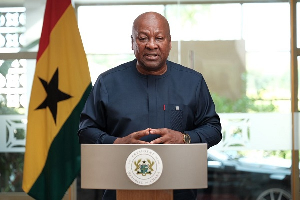I was a Level 100 student then, at the Ghana Institute of Journalism (GIJ). Our lecture for the day, at the make-shift Ghana Broadcasting Corporation (GBC) lecture hall, had ended and we were on our way back, to the GIJ campus.
The discussion was on. Everyone was heard saying a word or two about the Basic Computing lecture that we had that morning.
Terminologies such as ports, WAN, PDF, RAM, CD-ROM, and the likes, sounded to me like a fleet of cars tooting their horns in traffic much to the displeasure of angry pedestrians. I never had a clue of what “those things” were. In fact, I was more than a stranger in Jerusalem.
Prince, my colleague, stole a look at me, maybe dumbfounded, and said “Tim, in fact, you are an analogue man in a digital world.” The other students around us burst into uncontrollable and spontaneous laughter. I felt bad. But, Prince was right. He told the truth, bitter though.
Since that day, the phrase, ‘analogue man in a digital world’ kept ringing in my ears.
The truth of the issue is that unlike my colleagues in urban areas, I had no luxury of being exposed to the world of Information and Communications Technology (ICT) throughout my school days in the rural north of the country.
Am I the only one ?
My situation is just like a cup of water drawn from the flowing ocean. There are many thousands of people in the rural areas who have no access to ICT in this digital age. Perhaps, I can equally, by borrowing Prince’s words, refer to them as “analogue men in a digital world.”
According to the United Nations World Urbanisation Prospects, “rural population refers to people living in areas defined as rural by national statistical officers.” It is calculated as the difference between the total population and the urban population.
As of 2014, the rural population was estimated at 12,324,170, representing 46.7 per cent of the country’s population.
The Ghana Investment Fund for Electronic Communication (GIFEC)
In January 2004, the government, under the national ICT policy for accelerated development, instituted the Ghana Investment Fund for Electronic Communication (GIFEC) as an implementing agency of the Ministry of Communications. It was given the mandate to facilitate the provision of ICT internet connectivity and infrastructure to the underserved and deprived areas of the country. This was to enhance the direct participation in development and decision-making processes at local and national level. The legislation was subsequently promulgated in 2008 as the Electronic Communication Act 775. GIFEC is partnered by licensed telecommunication operators, the National Communications Authority (NCA) and some key ministries.
What has changed?
Has the digital divide between the rural and urban areas been bridged?
In an attempt to find out how GIFEC has lived up to its mandate, I interviewed the Administrator and Chief Executive Officer (CEO), Mr Kwabena Owusu Acheampong.
He told me that one of the key areas that GIFEC had made giant strides was rural mobile telephony, an initiative that fosters collaboration between GIFEC and licensed mobile phone companies to extend mobile communication services to underserved areas. According to him, 51 locations had been set up across the country to provide telephony services using mobile phone operators.
GIFEC has tremendously impacted the lives of rural people through the establishment of Community Information Centres (CICs). To facilitate access to ICT and the Internet, GIFEC has established CICs in rural and semi-rural areas, dotted across all the districts in the country.
“Information based on the review we have done on the CICs paints a very good picture about its impact on rural populations. A few of the CICs have some challenges; but a committee has been set up to review their operation so that we can revamp it hopefully by the end of the year”, Mr Acheampong told me during the interview.
The GIFEC Fact sheet proved that out of the 183 CICs that have been established, 105 have been equipped and are operating to meet the information needs of the communities.
The school connectivity project has also been initiated to provide educational institutions with high speed computers, printers, scanners, projectors, and servers; linking them to internet access. As a result, the 38 public colleges of education have all had their share of the ICT infrastructure. Also, 249 senior high schools, 323 junior high schools, and other 183 pre-tertiary vocational and technical training institutions have had their bread buttered in terms of access to ICT equipment from GIFEC.
It is on record that 2,200 rural payphones have been installed in communities, schools and colleges as part of the rural payphone project designed to enhance network quality at weak signal areas.
One component of the GIFEC ICT initiative which excites me is the library connectivity project. In collaborating with the Ghana Library Board (GLB), ICT equipment and internet connectivity has been provided to regional, district and mobile libraries across the country.
There are other projects to cater for the physically challenged, National Disaster Management Organisation (NADMO) and the security services, all targeted at connecting the rural folks to the digital world.
Why give GIFEC thumbs up?
The GIFEC initiative is not only expanding and sustaining the access of the rural poor to electronic communication to propel the growth of rural economies; it is also transforming the prospects of farmers, local businesses, and opening the rural areas to development.
For instance, the ICT for Sustainable Fishing (IFSF), an initiative to use fish-finder technology for fishing, is gradually transforming the lives of fishermen in some 18 landing sites in coastal communities.
“I have just received a proposal from an organisation to hook other farmers to the GIFEC initiative. A technical committee will review it and make recommendations. We could possibly expand to cover other rural farmers”, Mr Acheampong indicated.
As Ghana is on the verge of breaking fully into the realm of lower-middle income countries, the need to provide ICT infrastructure in every nook and cranny of the country is paramount. This way, all sectors would be strengthened, from the grass roots to enhance sustainable development.
Opinions of Tuesday, 8 December 2015
Columnist: Timothy Ngnenbe














